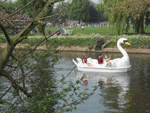3. Digitising an image
A very straightforward method of converting an image into a binary file is to create a 'bitmap' image file.
Imagine a photograph lying flat on a table and over that you place a transparent acetate sheet that has a fine rectangular grid of lines drawn on it.

As you look down at the sheet and photo, you effectively see the photograph divided up into hundreds or thousands of small rectangles. You have started to 'digitise' the photo.
However, this is still an analogue image because in reality the colour you see even within each rectangle could change within itself, as you can see in the crude rectangles you see in the photo above. So the next step is to only allow a *single* colour to be present within each rectangle.
Perhaps you have a system to work out the 'average' colour within the rectangle. Now you are getting close to a true digital picture because a single binary number can be used to represent the colour within each rectangle.
These rectangles are called 'pixels' which is short for 'picture element'. In the image below you can see the pixels starting to appear as jagged edges.

Challenge see if you can find out one extra fact on this topic that we haven't already told you
Click on this link: scan photographic image
